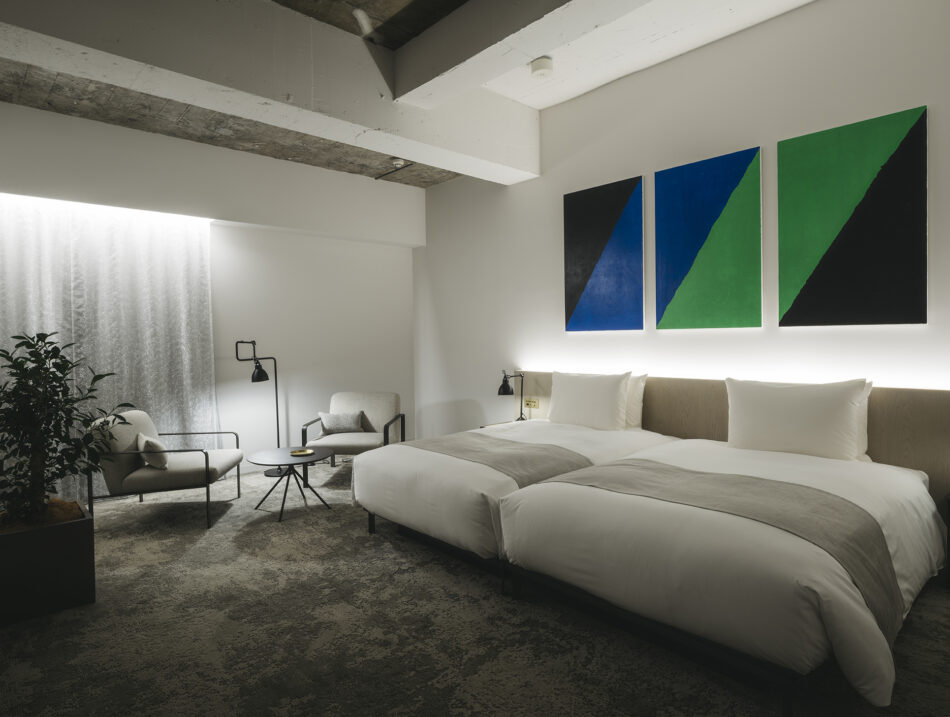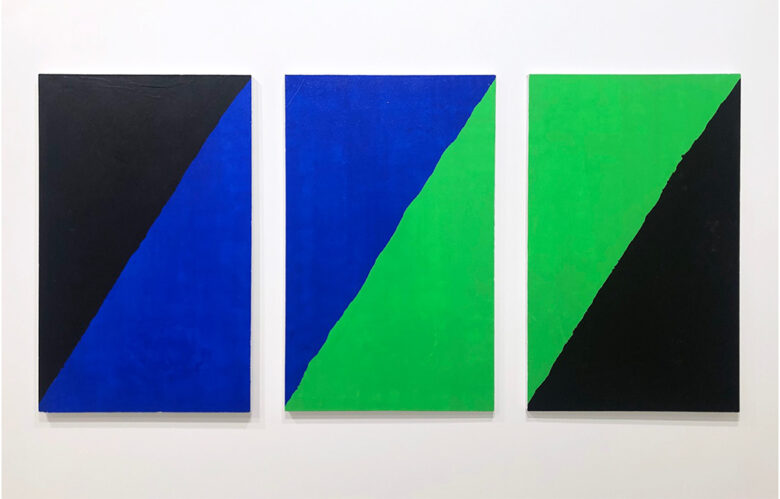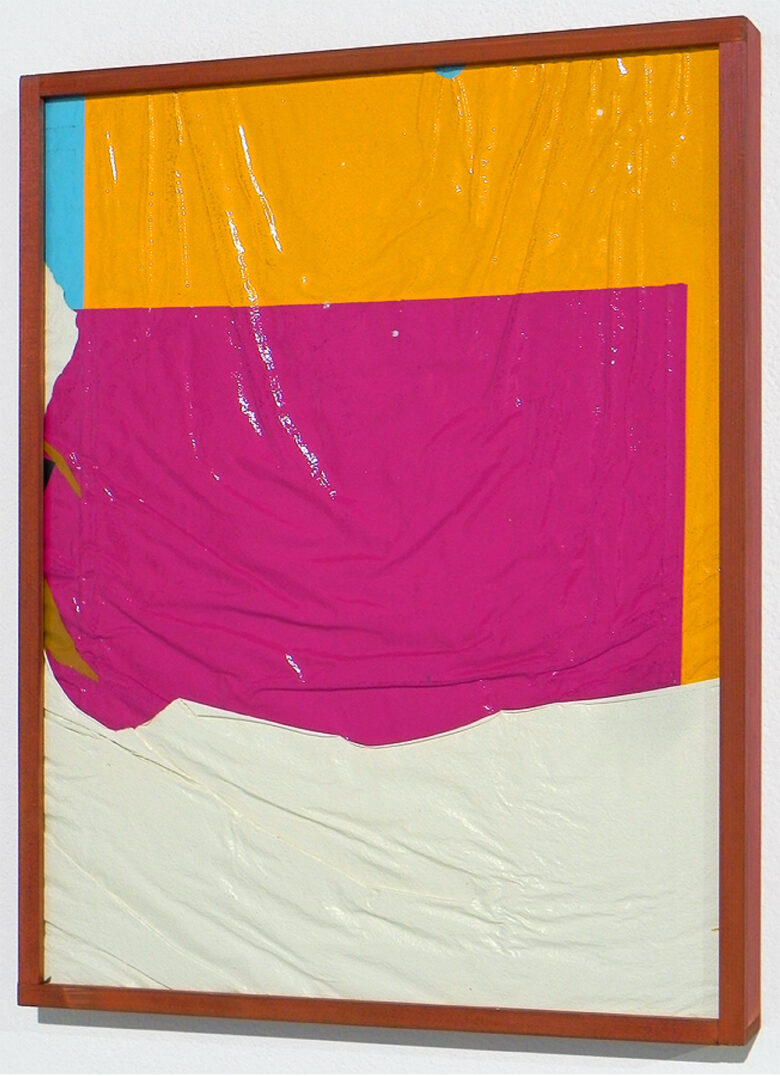ROOM 01 関口 正浩 / MASAHIRO SEKIGUCHI


開かれた旗 No.1 / Open Flag No. 1

遠くの正面#4 / Face from a Distance #4
1984年、東京都生まれ。2007年京都精華大学芸術学部造形学科洋画コース卒業。2012年京都市立芸術大学大学院美術研究科博士課程美術専攻油画中退。主な個展に、「まばたきのかたち」(2018年、児玉画廊、東京)、「Warped」(2017年、児玉画廊)、「project N 49 関口正浩 SEKIGUCHI Masahiro」(2012年、東京オペラシティー アートギャラリー、東京)、「反転・回転・反復」(2011年、児玉画廊、東京)など。主な展覧会に、「VOCA展2011」(2011年、上野の森美術館、東京)、「LOCA2007」(2007年、京都市芸術大学、京都)がある。
関口正浩の作品は、まずその大胆な色彩と色面に目を奪われる。おそらく混色をしていないであろう鮮やかな絵の具の色彩と、一つの画面を二分割するだけという極めてミニマムな要素によって画面が構成され、隣り合う画面には、同色が再度使われており、3色で構成された3枚の画面は永遠に繰り返されるような印象を与える。そして、接近してみると薄いビニールのような均質な質感の中に、偶然できた皺のような跡が見える。Oil on Canvasと書かれているが、画家の痕跡を現す筆致は一切見ることができず、本当に「油彩画」であるのか疑わざるを得ない。しかし、関口の制作は一貫してOil on Canvasにこだわり、絵筆を使わないことを特徴としている。《開かれた旗 No.1》は、樹脂製の板の上に、絵の具のチューブから出した原色のままの油絵の具を均一に塗り、完全に乾ききる前の生乾きのうちに薄く引き剥がし、その薄い膜をキャンバスに貼り合わせるという手法で作品を制作している。一見、単純に見える画面の中に、引き剥がした絵の具を張り付けるコラージュの技法、薄い膜を張り付けるという繊細な行為の身体性、画面の縁を見ると気付くことができるいくつかの絵の具の膜の層があり、一度引き剥がすことによって得た、絵の具自身の物質としての独特の強度が関口独自の絵画空間が生みだしている。1940年代後半に始まった抽象表現主義以後、あらゆる方法がやりつくされたといっても過言ではない絵画の領域においてもなお、Oil on Canvasに果敢に挑み続ける関口の作品は、見るものをも「絵画」の根源へと誘う。
Masahiro Sekiguchi was born in Tokyo in 1984. He graduated from the Oil Painting Course at Kyoto Seika University’s Faculty of Art in 2007. In 2012, he withdrew from a doctoral program in oil painting at Kyoto City University of Arts’ Graduate School of Arts.
His major solo exhibitions include reverse / revolve / repeat (Kodama Gallery, 2011), Warped (Kodama Gallery, 2017); project N 49 SEKIGUCHI Masahiro (Tokyo Opera City Art Gallery, 2012), and Blink of an Eye (Kodama Gallery, Tokyo, 2018). His major group exhibitions include LOCA2007 (Kyoto City University of Arts, 2007) and VOCA 2011: A Vision on Contemporary Art (Ueno Royal Museum, Tokyo, 2011).
Sekiguchi’s work begins by captivating the audience with bold hues and fields of colour. Each painting in Open Flag No. 1 combines vivid colours, presumably from unmixed paints, with the extremely minimal element of dividing the space in two diagonally. The colours used on adjacent screens overlap, creating a tricolored triptych that gives the impression of eternal repetition. Approaching the work reveals traces that appear to be accidental wrinkles in a homogenous texture like thin vinyl.
Despite the description “Oil on canvas”, one cannot but doubt whether these are truly “oil paintings”, as there are no brush strokes whatsoever revealing the painter’s hand. Nevertheless, Sekiguchi is consistently devoted to “Oil on canvas” in his work, one of its characteristics of which is the non-use of paintbrushes.Instead, he evenly spreads primary-coloured oil paints direct from the tube on resin plates, then peels the sheet of paint off while still half-dry and applies it to the canvas as a thin membrane.
The images may seem simple, but Sekiguchi creates a unique pictorial space through his technique of collaging torn paint, the physicality of the delicate act of handling paint as a membrane, and the characteristic strength imparted to the paint as a material through the peeling process, which can be recognised by examining the layers of paint membrane at the edges of the work. Sekiguchi’s fearless, ongoing challenge to the idea of “Oil on canvas” in the realm of painting, where every possible method has been employed since the rise of Abstract Expressionism began in the late 1940s, leads the viewer to the roots of painting itself.

